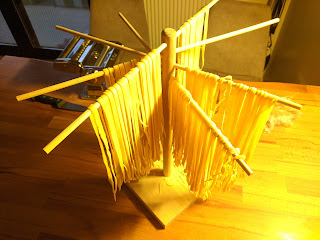Hello world! Today, I would like to share with you how we make pasta at home. As with most things, you can make pasta without any special equipment. The idea is to roll out a piece of though as thinly as possible and cut it into long strips if that is the kind of pasta that you like. But having the right equipment can speed up this process significantly. We make pasta using the
Marcato Atlas 150 Pasta Machine. Don't be fooled by the name machine; it is entirely hand operated.
The most critical thing for making homemade pasta is the recipe. The dough should be quite dry -- much more so than bread or pizza doughs. Also, we typically don't use any water or yeast. Just eggs and flour. Without further due, my pasta recipe is comprised of the following:
- 1 egg per 100 grams of all purpose white flour
It seems simple, isn't it? Well, traditionalists will recommend using semolina flour. I've tried both semolina flour and white flour. It is indeed true that semolina flour yields a more similar taste to traditional pasta. But the difference is not huge. Because it is more difficult to find semolina flour in my neck of the woods, I usually use all purpose white flour.
A second issue is the weight of the eggs. Not all eggs are created equal. Some eggs are markedly smaller than the average and some eggs are larger. The above recipe will work well if the weight of an egg is about 60-65 grams. The last time I made pasta, I used three eggs whose total net weight (without the shell) was 165 grams. So I used 290 grams of flour -- just a little less than 100 grams per egg.
One may wonder whether to use whole eggs, yolks only, or whites only. There is actually a
blog page that compares these three techniques in detail. Personally, I always used whole eggs and obtained great results.
Now that we have cleared these issues, let's talk about the process. Mix the ingredients in a glass bowl and start kneading by hand (3 eggs - 300 g of flour for a 4 person family suffices for us). Knead for about 10 minutes until you don't see dry bits of flour. If after 10 minutes kneading, there is still some unmixed flour it probably means you've used too much flour. You can discard those extra bits if kneading more does not appear to help.
Next, bring the dough to a ball shape and wrap it in stretch film. Put it in the refrigerator for at least 2 hours. Keeping it longer (4 hours or so) can even be better as during this stage the flour continues to absorb the moisture from the eggs.
About an hour before you want to cook your pasta take it out of the refrigerator. Cut a small piece from the dough (wrap the remaining piece to prevent it from drying) and compress it by squeezing it between the palms of your hands. Next, pass this piece from the machine as shown in the following video:
You want to pass the dough piece starting from the 0 setting of the machine. After you pass it from 0, turn the dial to 1, and pass it again. Continue this process until the dough is thin enough. I usually go all the way to 6 or 7. By the way, the instructions suggest passing the dough twice from each setting but it takes too much time and I think it is not absolutely necessary.
After the dough is rolled out to a thin layer, now cut it into thin strips using the cutter part of the machine. Again you can refer to the video for details. After the pieces are cut, you can hang them so that they don't stick to each other. Initially, I used an ad-hoc approach as can be seen in the video, but later I purchased a
specialized pasta hanger as can be seen in the following picture:

At this point, you have two options: Either immediately boil them for instant enjoyment or dry them out for later use. We usually boil and eat them right away as it is almost impossible to wait after having worked so hard for it. For boiling, I would recommend boiling them in small batches as to not cool down the water temperature. Make sure to add salt to the water before adding the pasta. They will be ready in 5 - 8 minutes depending on how you would like them to be cooked. Do not over cook them as they can become mushy and stick at each other. After we take out each batch from the boiling water to a bowl, we add a small amount of olive oil to prevent sticking and giving it an extra taste. If possible, try to use just the right amount of water so that after the last batch is cooked, there is almost no water left in the pan. We usually do not drain home made pasta to not wash away its nutritional benefits.
So, there you go. Let me finally share a picture of the finished product:
We usually eat this pasta with a home made tomato sauce sometimes adding meat to it. It also goes great with yogurt (
check out my recipe for making home-made yogurt). I hope you try and enjoy this recipe. If you have good suggestions for other pasta sauces, I would be delighted to hear!




Comments
Post a Comment